Humboldt Forum, Berlin
While in Berlin, how could I resist a visit to the Humboldt Forum – one of Berlin’s newest and most controversial museums, and Germany’s most expensive cultural project?


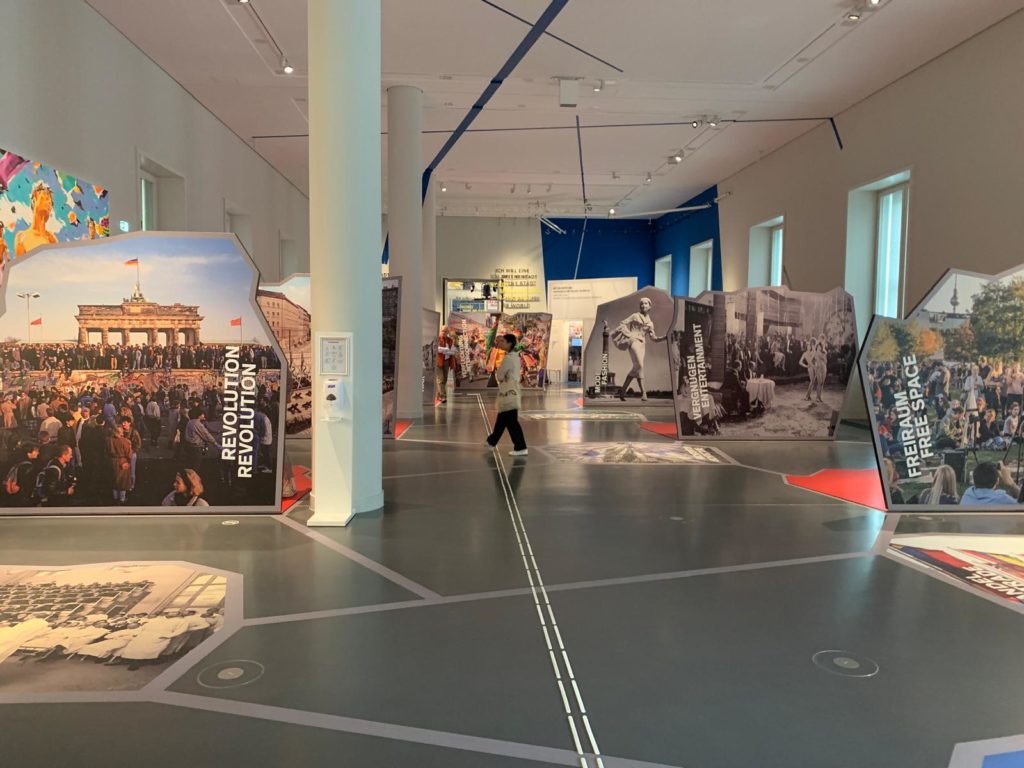



The Humboldt Forum – Who, Why, What, Where, When?
One museum I did not have the opportunity to visit on my last trip to Berlin was the Humboldt Forum. In fact, back in 2009, the last vestiges of the previous building to stand on this site were being removed. But as a museologist I was well aware on my return trip of some of the debates surrounding this new museum, and wanted to see it for myself. And so on a free Museum Sunday, I booked myself a ticket for a guided exhibition tour, and set aside some additional time to pootle around by myself. The results were interesting, although one quick visit didn’t feel like nearly enough.
But let’s start with the basics. What is the Humboldt Forum? It is a new museum in the Mitte district for Berlin’s collections of non-Western Art. Opening in 2020 virtually and 2021 physically, it brings together several institutions and collections, including the former Ethnographic Museum and Museum of Asian Art. The full list is: The Stiftung Humboldt Forum im Berliner Schloss, the Staatliche Museen zu Berlin / Stiftung Preußischer Kulturbesitz, the Humboldt-Universität zu Berlin and the Stadtmuseum Berlin. Sounds like an administrative nightmare.
And the ‘Humboldt’ in Humboldt Forum? That comes from scholars Wilhelm and Alexander von Humboldt. Aristocratic Prussians and Enlightenment figures, they were part of the intellectual elite and had an encyclopedic knowledge. Between them they learned about physics, archaeology, zoology, geology, economics, philology, anatomy and more. They travelled widely, and came up with inventions. Interesting figures with wide-ranging knowledge, to be sure. But also interesting figures who are very firmly part of Western systems of knowledge and cultural dominance. Which becomes interesting as we get deeper into the debates over the Humboldt Forum.






Berliner Schloss to Palast der Republik to Humboldt Forum
Just how did the Humboldt Forum become Germany’s most expensive cultural project? That is an interesting story. Let me take you back in time, first of all. What used to stand on this site was one of those Baroque palaces, like Schloss Charlottenburg which we learned about recently. Well it wasn’t always Baroque: the first incarnation dated to 1443. But Friedrich I of Prussia expanded it to a very large Prussian palace, and it was home to the House of Hohenzollern who were the rulers of the day (Electors, Kings and Emperors depending on the period). After the proclamation of the Weimar Republic in 1918, Berlin Palace (Berliner Schloss) became a museum.
Heavily damaged during WWII, the East German government decided to demolish Berlin Palace in 1950 rather than repairing it. In its place, they built the Modernist Palast der Republik (Palace of the Republic). A socialist people’s palace, this housed the East German parliament (Volkskammer) but also restaurants, entertainment and cultural venues, and infrastructure like a post office and police station. A very clear inversion of the exclusionary nature of a royal palace.
However, unfortunately for those who would have liked to see the Palast der Republik live on after Reunification, it was built using asbestos. A lot of asbestos. That was already illegal in East Germany at the time of the Palace’s construction. So it was demolished in its turn from 2006-2008. But what to do next?
As you can imagine, there were diverging opinions on this. But, as we know because I visited it, ultimately the decision was in favour of rebuilding Berlin Palace. Not exactly, though. Italian artist Franco Stella won the architectural contest. His submission combined recreation in some places with a Modernist twist in others. It is also flexible: for instance some rooms in his design are the exact proportions of the Berliner Schloss that was, allowing for reconstruction in future if desired. Construction took from 2013 to 2020, including the usual delays but also exacerbated by Covid. Fierce debate continued over this period, including over some of the finishing touches like whether to add a Christian cross to the dome (they did).

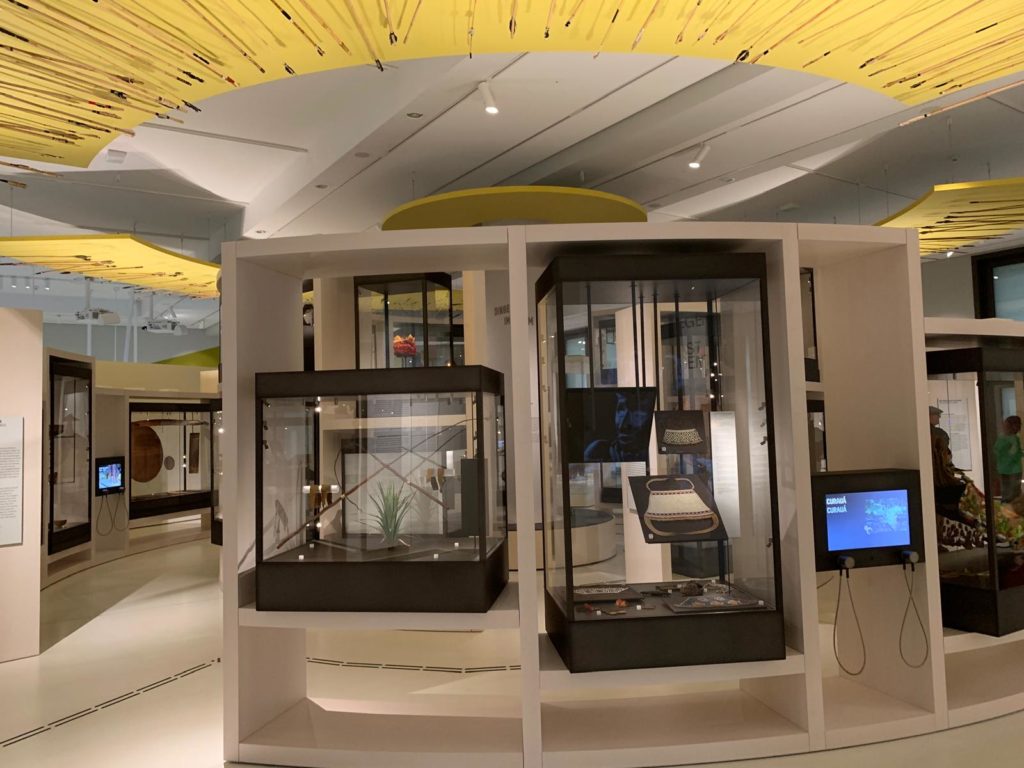




Conservative, Woke, or Both? An Exercise in Ensuring Nobody’s Happy?
This is all sounding pretty conservative, thus far. A project critics say amounts to “reviving a 15th-century palace that is charged with the symbolism of the Prussian monarchy, Christian dominance and colonial entitlement.” People were particularly angry about that cross. So there’s definitely a way to read this project as part of the current conservative tendency in Europe to take refuge in a past perceived to be greater. Ethnographic collections themselves are increasingly under scrutiny these days. Supporters argue the benefits of accessing ‘encyclopedic’ collections, learning about other cultures and providing access to all. Detractors see such institutions as perpetuators of Western “othering”, and challenge the immoral and/or illegal hoarding of objects collected at best under unequal power dynamics, at worst as a result of seizure and looting. The sort of thing that is ripe to act as a battlefield in the ‘culture wars’.
Interestingly, given the apparently conservative bent of its physical home, the Humboldt Forum leans more the other way in terms of its presentation. One of the points in their mission statement reads as follows:
“We are a space for critical debate on current social issues. Irritation with and uncertainty about traditional convictions have their place here because they are important stimuli for questioning structural inequalities, including in regard to the creation of knowledge. We don’t sit on the fence and we don’t avoid tension. Opposition is welcome.”
Mission Statement | Humboldt Forum
To me, this sounds great. I love when museums spark debate, are honest about themselves, are participatory, and otherwise fulfil their important social role. But it does then seem to me that the Humboldt Forum puts itself at risk of making nobody happy. On the one hand, the conservatives have a building that seems to meet their needs but has a lot of wokery in its interior. On the other hand, progressives might engage with the internal displays, if they can overcome the hurdles of the building and the collections in order to enter.
Whether this approach will weather the increasing polarisation that’s taking place in Germany and elsewhere, only time will tell.
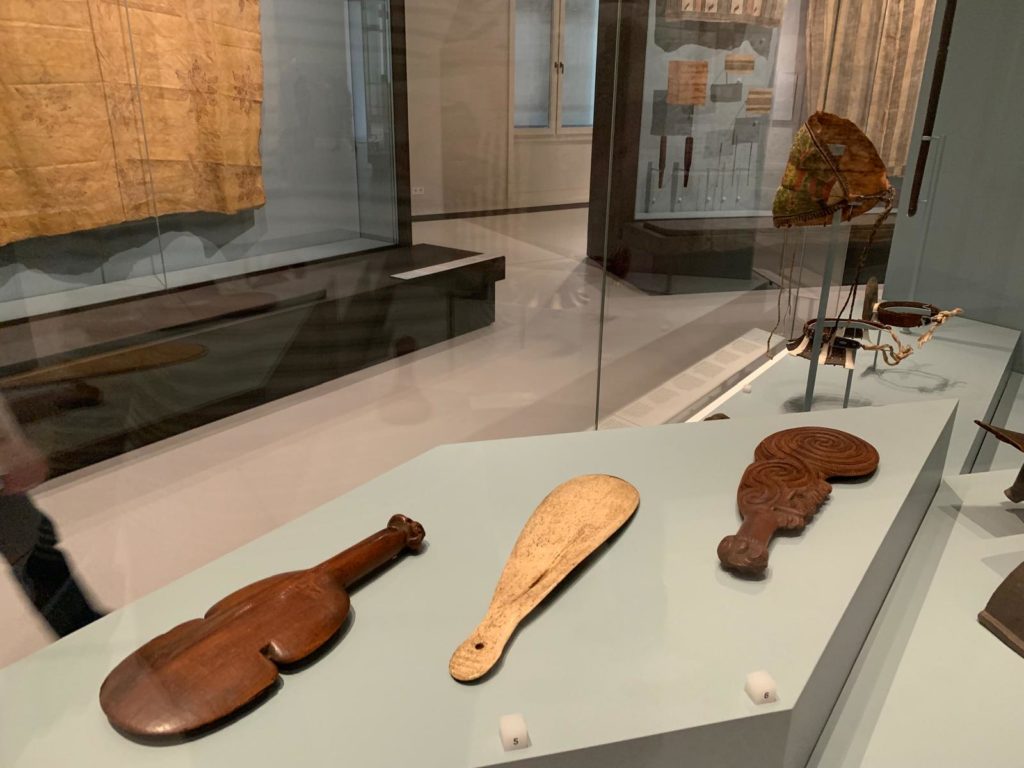





A Few Words on the Collection and Exhibitions
That’s quite a bit of background and opinion. Let’s now take a look at what’s inside the Humboldt Forum. I should note first that ticketing is a little complicated. I visited on the first Sunday of the month which meant entry was free, but I still needed tickets. Separate ones for different exhibitions, and one for the roof if you want to go up there. And they’re all timed. Others were struggling with this too when I visited – head to the ticketing desks in the central foyer and make sure you have everything you need before you set off. You can also book online.
To get a sense of the Humboldt Forum I had to whip around at breakneck speed. I would like to go back in future and take my time in areas that interest me. But what I did see, I found impressive. I started with an exhibition, Berlin Global, which positions Berlin as part of a connected world. It’s big, interactive (you can ‘vote’ at various points by passing through different doorways), and covers many different themes. I thought it was a good demonstration of the way exhibition programming allows the Humboldt Forum to put Germany on an equal footing with the other cultures the collections represent.
After my tour (more on this shortly), I went to explore those other cultures. So many of them: more than I could count. What I appreciated in the way they were presented was the Humboldt Forum’s adherence to their mission. They do not shy away from difficult histories and controversial perspectives. It’s not always comfortable viewing, but it’s so important. And ultimately, I believe visitors get so much more out of this than simply viewing an uncritical catalogue of objects. If you want to experience some of it for yourself, check out these digital resources.






Exhibiting.Omissions.
I structured my visit to the Humboldt Forum around a guided tour in English of the exhibition (workshop?) Exhibiting.Omissions. The museum’s website describes the exhibition’s purpose as follows:
“The workshop exhibition Exhibiting.Omissions. Objects from Tanzania and the Colonial Archive questions, remembers, and reconsiders the museum’s objects and their stories: to whom and where did the objects now in the museum’s depot belong? What stories do they have to tell that remain untold or ignored to this day? Should these objects still be on display in Berlin today? And what omissions do we encounter when reflecting on these issues, what remains hidden?”
Exhibiting.Omissions. | Exhibition at Humboldt Forum
I found the concept fascinating. It confronts, head on, some of the controversies around the institution’s ethnographic collections. And more than that, it looks beyond presumed restitution of some of these objects, and imagines the future. Without, importantly, assuming that all the questions have been answered. Questions of which objects and stories it is appropriate to tell, and how they can most appropriately be told.
I had an experience during this tour which I found quite telling. The audience for a tour in English of an exhibition which takes a contemporary approach to objects with a problematic colonial and racist past is pretty self-selecting. Or so I would have thought. Most of the people on the tour were certainly on the same wavelength. But the late arrival of a local pair whose views were more conservative was jarring. Their questioning of the value of trying to interpret objects in different ways felt out of place, as did their resistance to the idea of returning such objects to their country of origin. But in reality, it was mostly jarring within the little bubble of our group. Plenty of people feel the same way. I come back again, then, to the conservative and progressive tendencies the Humboldt Forum holds in an uneasy tension.

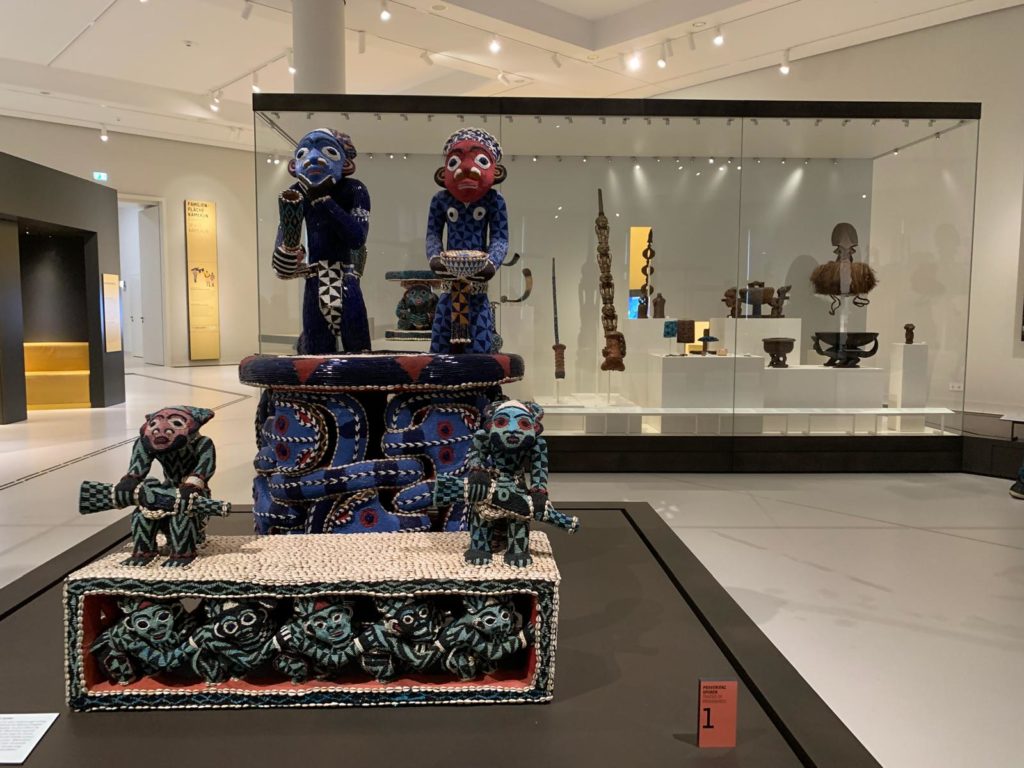



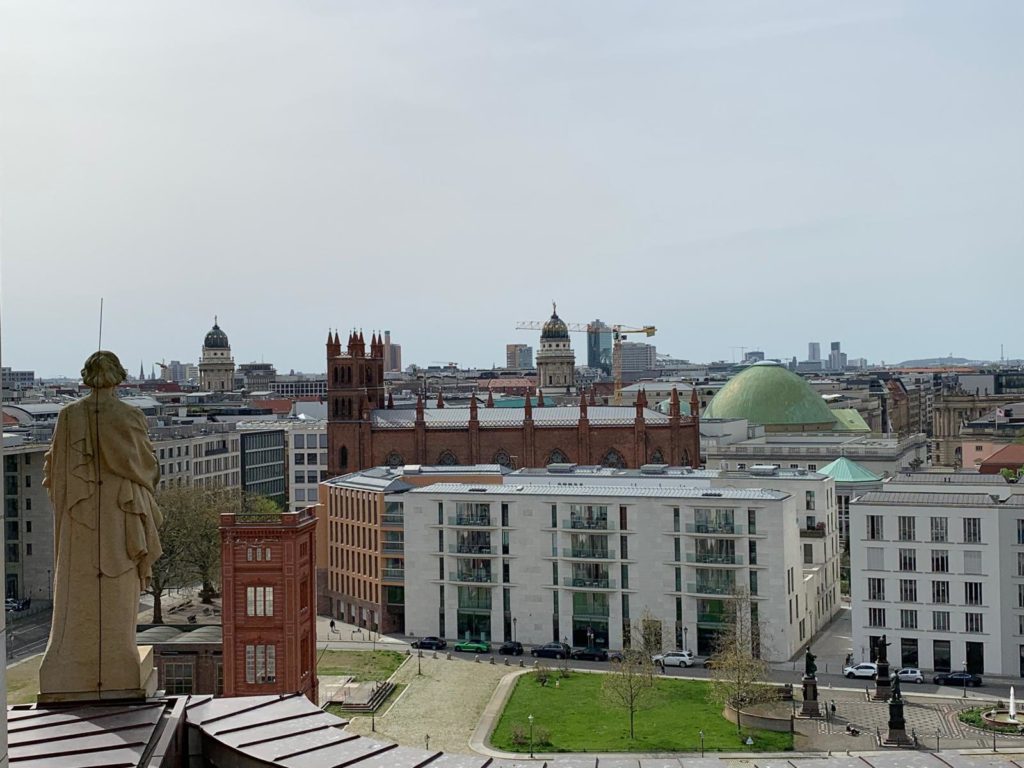
Final Thoughts on the Humboldt Forum
And so as my final activity at the Humboldt Forum I made my way up to the rooftop. A good place to look out over Berlin’s Museumsinsel (Museum Island) and think about things. Also the best place to get a view of some of those controversial finishing touches, including the cross on the dome.
But frankly I didn’t know a lot of that history of the building until I was preparing to write this post. I left the Humboldt Forum invigorated by its approach to questioning and confronting and creating dialogue. Because even that difficult interaction I outlined just above is dialogue. Maybe that pair left with the same ideas they entered with. Maybe they didn’t. But it’s a conversation that wouldn’t have been forced into the open without that particular exhibition. Multiply that many times over to represent all the exhibitions, displays, talks and events the institution curates and programmes, and you can see what I mean about the important social role of museums.
I am an outsider in Germany, and there are probably many aspects of this complex story I missed. But I really enjoyed the Humboldt Forum. It was probably the cultural highlight of my trip to Berlin. And a place I would like to return to and bring others to. With its central location, interesting old/new architecture and thought-provoking displays, I recommend it to a wide range of open minded visitors to Germany’s capital.
Salterton Arts Review’s rating: 4/5
Exhibiting. Omissions. concluded on until 16 June 2024
Trending
If you see this after your page is loaded completely, leafletJS files are missing.


At the start, I wondered why call the place a ‘forum’? – now I see why.
Indeed! A great place for conversations – not always easy ones but that would probably be boring if they were.